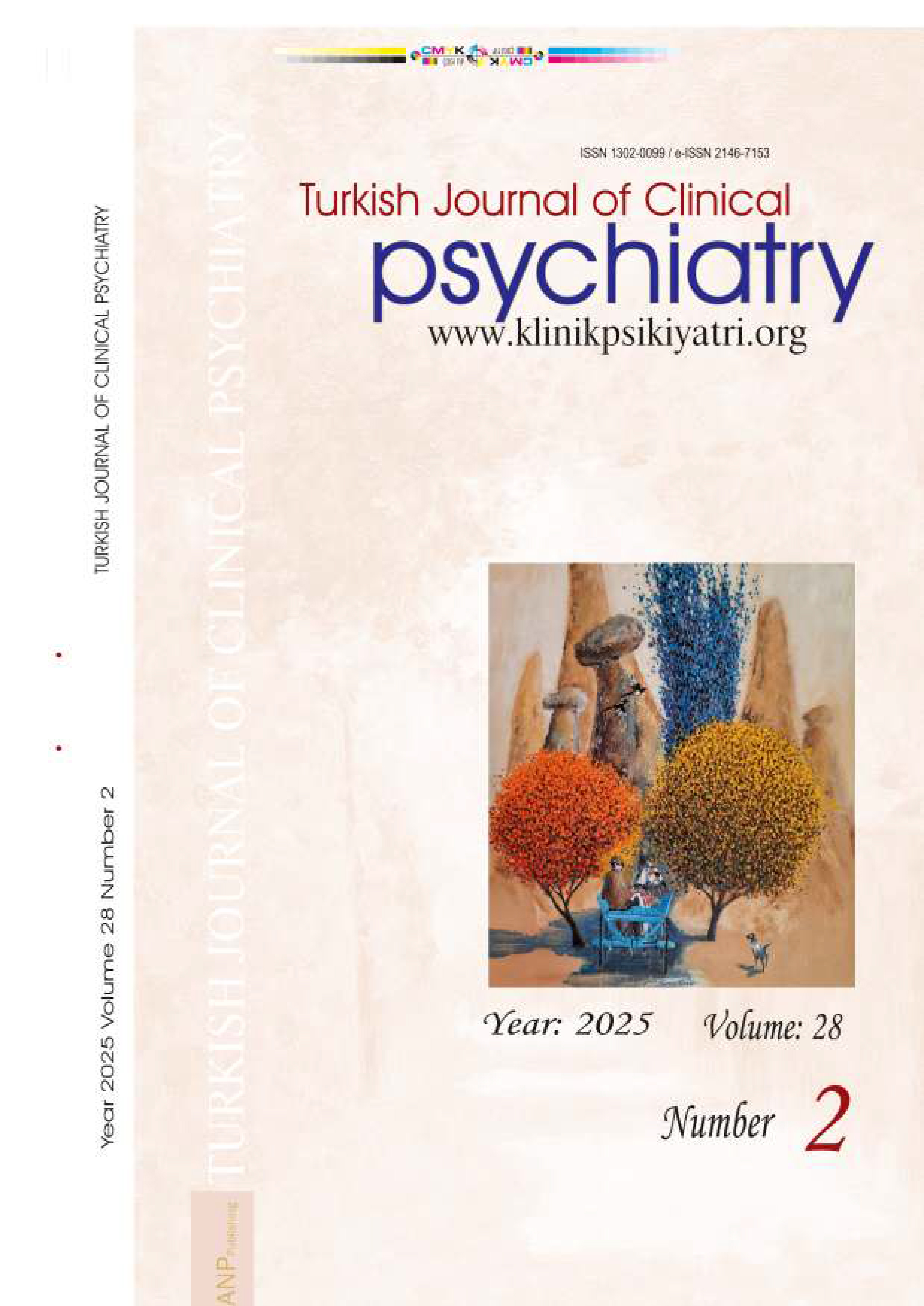





Volume: 26 Issue: 3 - 2023
| EDITORIAL | |
| 1. | What do the amendments to the associate professorship exam regulation mean? Burhanettin Kaya doi: 10.5505/kpd.2023.95871 Pages 151 - 154 |
| RESEARCH ARTICLE | |
| 2. | Decreased serum levels of glial markers and their relation with clinical parameters in patients with schizophrenia İhsan Çetin, Ömer Faruk Demirel, Tarık Sağlam, Nazım Yıldız, Alaattin Duran doi: 10.5505/kpd.2023.81557 Pages 155 - 162 INTRODUCTION: The neurodevelopmental hypothesis of schizophrenia suggests that alterations of glial fibrillary acidic protein (GFAP) and glial cell line-derived neurotrophic factor (GDNF) functions may play a role in the pathogenesis of schizophrenia. However, there is limited information about the relationship of these molecules with the clinical features of schizophrenia. In this study, it was aimed to compare patients with schizophrenia and healthy controls in terms of serum GFAP and GDNF levels and to investigate the effects of clinical parameters on serum levels of molecules in patients with schizophrenia. METHODS: 37 patients with schizophrenia followed in the psychosis unit and 37 age- and sex-matched healthy controls without a history of psychiatric disease were recruited in study. The patients evaluated through the Turkish version of positive and negative syndrome scale. On the other hand, sociodemographic question form was applied to both the patients and the healthy controls. RESULTS: Serum GDNF and GFAP levels of patients with schizophrenia were significantly lower than those of healthy controls. Furthermore, serum GDNF levels were negatively correlated with general and negative syndrome scales (PANSS) in these patients. DISCUSSION AND CONCLUSION: It has been observed that there is a relationship between PANSS and changes in the GDNF levels of schizophrenia patients. However, larger clinical studies in which these markers are also measured in cerebrospinal fluid are needed to understand the biological mechanisms underlying these associations and to understand whether glial markers could be useful as biomarkers for the diagnosis of schizophrenia. |
| 3. | The frequency of OPRK1 G36T and OPRM1 A118G opioid receptor gene polymorphisms in heroin-dependent individuals and non-dependent healthy subjects in Turkey Gunnur Demircan, Tuğçe Toker Uğurlu, Gülizar Zengin, Ata Onur Kepenek, Selim Can Berk, Damla Saygin, Idea Nehir Ozliman, Figen Ateşci, Demet Akın doi: 10.5505/kpd.2023.73693 Pages 163 - 169 INTRODUCTION: Polymorphisms of the Mu opioid receptor (MOR) gene (OPRM1), which encodes for the primary action site of heroin, have also been found to be associated with heroin addiction. The aim of this study was to investigate the relationships between heroin addiction and G36T OPRK1 and A118G OPRM1 receptor gene polymorphisms in a male population in Turkey. METHODS: 102 male patients with heroin use (without any other drug use) and 82 subjects without any history of opioid use were evaluated. The A118G and G36T SNPs on the MOR and Kappa opioid receptors (KOR) genes were assessed via TaqMan 5’-exonuclease allelic discrimination assays. RESULTS: The mean duration of heroin use was 4.6±1.9 years. The G36T polymorphism and heterozygous genotype were both found to be more frequent in the patient group (OPRK1 gene). In the patient group, 79 (77.5%) patients had wild-type genotype and 23 (22.5%) patients had mutant genotype. In the control group, 76 (92.7 %) subjects had wild-type genotype and 6 (7.3 %) subjects had mutant genotype (p=0.005). Wild type allele frequency was determined to be 0.894 and mutant type allele frequency was 0.105. With regard to the A118G polymorphism, we found that there was no difference between groups in terms of genotype. DISCUSSION AND CONCLUSION: Our findings support a considerable role for OPRK1 in opioid addiction; however, in conflict with most studies, we did not determine a relationship with A118G in Turkish subjects. We suggest that further studies should be conducted to ascertain the clinical implications of opioid gene polymorphisms in Turkey. |
| 4. | Evaluation of substance induced and substance free first-episode psychosis in terms of inflammatory whole blood count parameters Hidayet Ece Arat Çelik doi: 10.5505/kpd.2023.14564 Pages 170 - 176 INTRODUCTION: Substance use is known to trigger psychotic episodes in individuals predisposed to psychosis. Recently, the importance of inflammatory processes in psychotic disorders has been increasingly emphasized. This study aimed to examine the manner in which inflammatory whole blood count (WBC) parameters change in substance-induced first-episode psychosis (siFEP) and substance-free first-episode psychosis (sfFEP). METHODS: The present study included 32 patients with siFEP, 48 patients with sfFEP, and 80 healthy controls. For the comparison of inflammatory WBC parameters between the three groups, age and sex were considered as covariates when MANCOVA was applied; further, LSD post hoc test was performed. The relationship between clinical variables and inflammatory WBC parameters was analyzed using Pearson’s correlation analysis. RESULTS: Monocyte levels were higher in patients with siFEP than in those with sfFEP and healthy controls, and platelet-to-lymphocyte ratio values were lower in patients with siFEP than in healthy controls. Furthermore, a moderately significant relationship between duration of illness and monocyte levels was found in the siFEP group. DISCUSSION AND CONCLUSION: The fact that inflammatory WBC parameters differ among the siFEP, sfFEP, and healthy control groups suggests that inflammatory processes contribute to psychotic disorder. However, the data from the present study are still insufficient to support the use of these parameters in clinical practice. |
| 5. | Does the coexistence of attention deficit hyperactivity disorder and sluggish cognitive tempo affect the treatment response in children? Çiğdem Yektaş, Ali Evren Tufan, Elif Sümeyra Kaplan Karakaya, Merve Yazıcı, Enes Sarıgedik doi: 10.5505/kpd.2023.23500 Pages 177 - 185 INTRODUCTION: We aimed to evaluate treatment response in children with sluggish cognitive tempo and attention deficit/ hyperactivity disorder. METHODS: Child Behavior Checklist and Barkley Child Attention Scale were used to define SCT symptoms. Parents and teachers completed Turgay DSM-IV-Based Screening Scale for Disruptive Behavior disorders, severity and improvement were evaluated via Clinical Global Impressions Scale- Severity and CGI- Improvement. Methylphenidate responses were evaluated retrospectively by patient charts. RESULTS: SCT + ADHD group was rated as more inattentive by their parents while teachers rated children with ADHD as more hyperactive/ impulsive (p<0,01; p<0,01, respectively). Symptom reduction was significantly greater for teacher rated hyperactivity/ impulsivity in the ADHD group and children with SCT+ ADHD were still rated as more inattentive by their parents after treatment. The sole predictor of treatment response in the SCT+ ADHD group was treatment duration (p=0.012). DISCUSSION AND CONCLUSION: Longer treatment duration seemed to be more effective in the SCT group. |
| 6. | The effects of COVID-19 pandemic and lockdown on internet, smartphone use and emotional-behavioral problems in adolescents: A longitudinal study Damla Eyüboğlu, Murat Eyüboğlu, Deniz Bayar, Özge Tekeli, Deniz Namıduru, Nazlı Ece Ünal, Büşra Ece Yavuz doi: 10.5505/kpd.2023.46144 Pages 186 - 192 INTRODUCTION: Young people had adverse emotional and behavioral effects due to the pandemic and restricted measures, which caused social isolation, spending more time online with smartphones, tablets, and computers. We aimed to investigate adolescents' emotional/behavioral problems and internet/smartphone usage features during this pandemic and to compare the findings with the pre-pandemic features. METHODS: The sample consisted of 57 adolescents (27 males, 30 females). Data were collected at two-time intervals: before the COVID-19 pandemic [T1] and during the COVID-19 pandemic [T2]. All participants fulfilled the Strengths and Difficulties Questionnaire (SDQ), The Young’s Internet Addiction Test (IAT), Smartphone Addiction Scale-Short Version (SAS-SV). RESULTS: The results indicated that both internet and smartphone use duration significantly increased at T2(P < 0.001). With regards to SDQ, emotional symptoms, hyperactivity problems, prosocial behaviors, and total difficulties subscales were significantly worse at T2 than T1 (P < 0.05). Additionally, significant correlations were found between IAT and SAS scores and SDQ behavioral problems, hyperactivity-inattention subscores, and total difficulties scores (P<0.001). Finally, according to regression analysis hyperactivity-inattention problems increased the risk of problematic internet use (P < 0.05). DISCUSSION AND CONCLUSION: We objectively observed internet and smartphone use increase and relations with emotional and behavioral problems among adolescents during the outbreak of Covid-19. Therefore, these results should be carefully kept in mind while developing health policies for the long-term effects of the pandemic, whose duration is not yet known. |
| 7. | The effect of Sars-CoV2 pandemic on consultations of a child and adolescent emergency psychiatry clinic Binay Kayan Ocakoglu, Mehmet Can Erata, Gökce Elif Alkaş, Ayşegül Tonyalı, Gül Karaçetin doi: 10.5505/kpd.2023.99075 Pages 193 - 200 INTRODUCTION: Our study aims to investigate how the pandemic has affected the emergency department (ED) visits and to assess whether COVID-19 pandemic changed the presentations of diagnoses /chief complaints of the patients across three years. METHODS: This is a retrospective study. The study population was described as all patients who applied to our Pediatric Psychiatry ED from March to May of 2019, 2020 and 2021. RESULTS: The overall number of child and adolescent psychiatric emergency department visits declined by 49.5% in 2020 during pandemic period with implementation of COVID-19 related measures. From the corresponding period of 2021, the total number of ED visits have increased to a higher level than the same period of 2020 and even 2019. In 2020 and 2021, compared to 2019 (26.1%); there was a decrease of patients being admitted to the inpatient unit. We also found that the ratio of patients who were diagnosed with autism spectrum, mental retardation, depression, trauma and related, anxiety and obsessive-compulsive disorders got increased. DISCUSSION AND CONCLUSION: The immediate drop in visits to ED after the first pandemic restrictions may reflect people being more hesitant to hospitals at the beginning. But one year later, in the mid-pandemic period, the rise in visits to ED could have been because people got used to the pandemic or the need for acute psychiatric care cannot further be postponed. The decrease of admissions to the inpatient psychiatric unit may be a result of COVID-19 related measures as total number of beds got reduced due to restrictions. |
| 8. | Resilience, depression and burnout levels in caregivers of patients followed in the forensic psychiatry service Sevler Yıldız, Aslı Kazğan Kılıçaslan, Burcu Sırlıer Emir, Osman Kurt, Kerim Uğur doi: 10.5505/kpd.2023.67434 Pages 201 - 208 INTRODUCTION: It is known that psychiatric diseases also affect the quality of life of patients' relatives. The aim of this study is to examine the level of resilience, depression and burnout of the caregivers of forensic psychiatry patients in order to recognize the mental problems that may be experienced by relatives of forensic psychiatry patients who have committed crimes in addition to psychiatric illness. METHODS: 90 high-security forensic psychiatry patient relatives were included in the study. Sociodemographic data form, Beck Depression Inventory (BDI), Adult Resilience Scale (RSA) and Maslach Burnout Inventory (MBI) were administered to all participants. RESULTS: BDI score of caregivers was 10.8±7.7, RSA-total 99.8±12.5, emotional burnout score from MBI subscales 22.5±3.4, depersonalization score 9.4±2.2, personal success score was determined as 16.8±5.4. There was a significant difference between the duration of caregiving in terms of BDI score (p<0.01). The BDI score of the caregivers of the patients with criminal liability was found to be significantly higher than the score of the caregivers of the patients without criminal liability (p< 0.01). DISCUSSION AND CONCLUSION: : It was observed that the level of psychological resilience was good in people who took care of psychiatric patients who were subjected to forensic psychiatric examination, but they had mild depression and moderate burnout. It is seen that the relatives of the patients are affected psychologically and the necessary psychosocial support can be positive for the caregivers. |
| 9. | Investigation of adolescents diagnosed with exogenous obesity in terms of Internet, smartphone usage characteristics and psychopathologies Gülnur Baş, Ömer Kardaş, Burcu Kardaş, Edip Ünal doi: 10.5505/kpd.2023.64872 Pages 209 - 218 INTRODUCTION: In this study, it was aimed to investigate comorbid psychopathologies, internet/smartphone addiction and usage characteristics in adolescents diagnosed with exogenous obesity. METHODS: 48 obese subjects aged 12-18 years, diagnosed with exogenous obesity, and 49 healthy adolescents without obesity were included in the study. Comorbid psychopathologies were screened with the “Schedule for Affective Disorders and Schizophrenia for School-Age Children-Present and Lifetime Version (K-SADS)”. Young Internet Addiction Scale (YIAS), Smartphone Addiction Scale-Short Form (SAS-SF), Addiction Profile Index-Internet Form (BAPINT) were administered to the patient and control groups; Atilla Turgay DSM-IV-Based Screening and Evaluation Scale for Conduct Disorders in Children and Adolescents was applied to their parents. RESULTS: As a result of our study; In the case group, the presence of mental illness and obesity in the family, the duration of internet and smart phone use, snacking in front of the screen and spending time in virtual games were found to be significantly higher (p<0.05). In terms of the scales, it was determined that the YİBÖ, ATBÖ, BAPİNT and Atilla Turgay Scale scores were significantly higher in the case group (p<0.05). As a result of K-SADS, it was seen that adolescents with exogenous obesity had more psychiatric diagnoses when compared to the control group. DISCUSSION AND CONCLUSION: Our study shows that besides the biological aspect of obesity, it also progresses with a high rate of mental problems. Considering the difficulty of obesity treatment and the excess of complications, biopsychosocial interventions and multidisciplinary approaches including mental health professionals are important for the prevention and treatment of pediatric obesity. |
| REVIEW | |
| 10. | A current overview of palliative care: Palliative psychiatry Emel Erdeniz Güreş, Azize Atlı Özbaş doi: 10.5505/kpd.2023.60252 Pages 219 - 226 Palliative psychiatry is an approach that aims to improve the quality of life of patients and their families by trying to prevent or alleviate suffering through timely evaluation and treatment when faced with physical, mental, social, and spiritual problems associated with serious life-threatening mental illnesses. The fact that individuals with serious mental illness are a disadvantaged group in accessing health services, the rate of physical diseases that are difficult to treat compared to the general population is quite high in this population, their physical diseases are diagnosed later and their compliance with treatment is more difficult, this special group continues to live with a low quality of life and it results in death at an earlier age of 15-20 years. Therefore, considering the burden of serious mental illness on both the family and society, it is clear that palliative care is needed. However, the need for palliative care for individuals with psychiatric illnesses remained in the background, and discussion of the need for palliative care became possible at the beginning of the 21. century. This study was written to raise awareness about where we are in benefiting from palliative care services in our country and in the world and to draw attention to the role of psychiatric nurses, whose role in patient advocacy is at the forefront, in psychiatric palliative care. Psychiatric nurses should realize that there is a serious gap in the field of psychiatric palliative care in our country and should focus on studies in this field. |
| CASE REPORT | |
| 11. | A psychogenic dysphonia treated with sertraline: A case report Doğancan Sönmez, Çiçek Hocaoğlu doi: 10.5505/kpd.2023.61482 Pages 227 - 231 Psychogenic dysphonia (PD) is the inability of the structurally normal vocal cords to perform their proper vocalization function. In other words, it can be defined as the inappropriate or incorrect use of the normal vocal organ. The role of emotional stress is important in the formation of psychogenic dysphonias. It is a transformative clinical condition that is difficult to diagnose and treat. There are various studies in the literature regarding the diagnosis, evaluation and treatment approaches of patients with psychogenic dysphonia. The combination of sound therapy and psychotherapy is often used together, as psychogenic dysphonia symptoms and psychological factors mutually influence each other. There are limited studies on pharmacotherapy in treatment. In this case report, it is aimed to discuss a male psychogenic dysphonia case who responded dramatically to sertraline treatment in the light of the literature. |










